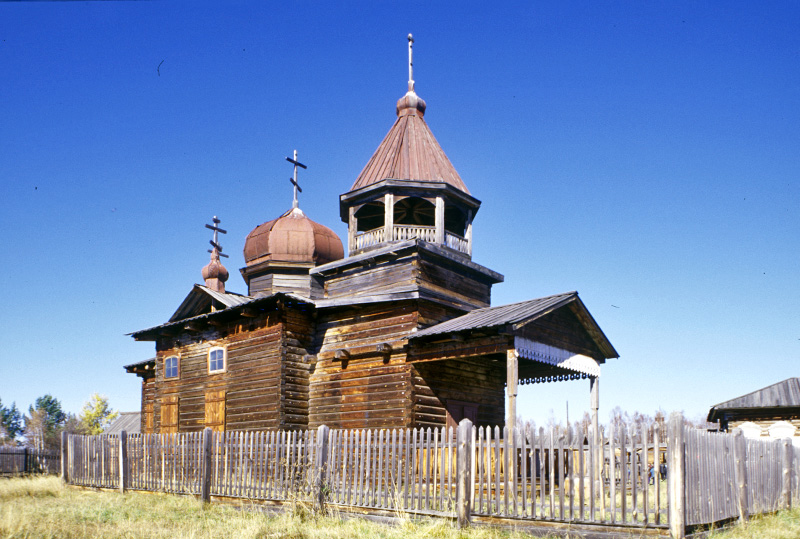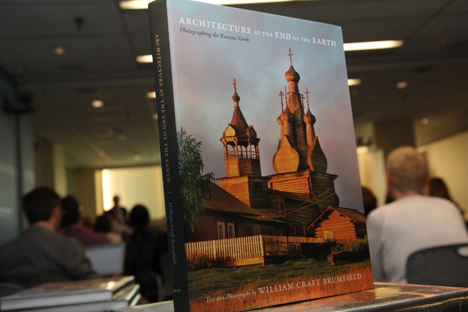Taltsy: Museum of traditional culture near Lake Baikal

Photographs by William Brumfield
Russia’s outdoor museums of wooden architecture have become an enduring part of the cultural landscape. From expansive territories such as Kizhi and Malye Korely in the Russian North to the relatively small but rich collections at Vitoslavlitsy (near Novgorod) and Suzdal, these museums are a tribute to the inexhaustible resourcefulness and creativity of Russia’s master carpenters and craftsmen.
One of the most distant of these museums is Taltsy, located at a picturesque site among the forests midway between the Siberian city of Irkutsk and the village of Listvyanka, on the southwest shore of sacred Lake Baikal. In a recent innovation, a number of the reconstructed log structures now have displays of traditional dress as well as recent fashion. Taltsy even boasts a surprising connection with Russian America.
Although the origins of the museum at Taltsy date from the early 1960s, a Russian settlement at the site, located near the confluence of the Taltsinka River with the Angara, can be dated much earlier. In 1758, for example, there is written evidence of a convent in the area.
In the 1780s, this remote site brought together two major figures in the study and development of Siberia: Alexander Baranov (1746-1819) and Erik (Kirill) Laxman (1737-96), each of whom gained renown as world travelers. Baranov, an entrepreneur and explorer from the northern town of Kargopol, moved his operations to Irkutsk in 1780. Ten years later, he became chief administrator of the Northeastern Company, which in 1799 was reorganized as the Russian-American Company — the organization that managed Alaska and Russian America.
Erik Laxman was born in Finland (which was at the time a part of Sweden), and at the age of 24, moved to St. Petersburg, where he taught in the city’s Lutheran School. Two years later, he was sent as pastor to a Lutheran parish in distant Barnaul, a major Russian mining settlement on the Ob River near the Altai Mountains.
Some might have seen this as a form of exile, but Laxman was fascinated by the variety and richness of Siberia. Spurred by boundless curiosity and intelligence, he became a major authority on the region in several disciplines. Returning to St. Petersburg in 1769 as an acknowledged scholar, Laxman spent the next decade on expeditions throughout the European part of the Russian Empire before returning to Siberia in 1781.
How to get there:
Drawn in the early 1780s to the cultural and administrative center of Irkutsk, Laxman explored the surrounding area and discovered deposits of sand rich in silica at the Taltsy site. Learning of the discovery, Baranov brought his entrepreneurial skills to Laxman, and together they formed the Taltsy glass factory, which met an acute need for glass containers throughout the Far East and into Alaska.
Other enterprises arose at Taltsy, which functioned as a factory settlement, throughout the 19th century. Although its significance declined at the beginning of the 20th century, the settlement and glass factory existed until the late 1950s, when the area near the Angara River was submerged with the creation of the Irkutsk Hydroelectric Station. The usable parts of the glass factory were moved to another location.
By virtue of steep cliffs above the Angara, part of the Taltsy site remained above the new reservoir. At the same time construction of the Ust-Ilim Hydroelectric Station elsewhere on the Angara River threatened one of Siberia’s most important historical monuments, the 17th-century Ilim Fort, with its impressive Savior Gate tower (1667) and portions of the fort walls, as well as the small Church of the Kazan Icon of the Virgin (1679) — all built of logs.
In 1966, the regional administration authorized measures to save the Ilim monuments by creating a museum park near Irkutsk. The Taltsy site was recommended by Galina Oranskaya (1913-1986), a Moscow-trained architect and preservation specialist who became the guiding light of historic preservation in Irkutsk. Construction work at the museum site began in 1970, with years spent in finding and reconstructing traditional log structures from the vast Irkutsk territory. The museum opened in 1980.
Taltsy consists of three active sectors. (A fourth is in the development stage.) The largest is the Angara-Ilim sector, whose centerpiece is formed by the 17th-century log structures from the Ilim area. The Ilim fort (ostrog) arose in the summer of 1630, when 28 Cossacks led by Ataman Galkin made their way up the Angara to fertile lands at the mouth of the Ilim River. Their winter camp (zimovye) was replaced by a log fort the following year.
The early forts succumbed to the fires that plagued Russia’s wooden villages, but portions of a third fort, built in 1667, endured for three centuries. The Ilim fort consisted of a rectangular stockade wall with vertical logs pointed at the top. The wall was anchored by eight log towers, including four on the corners. Three of the towers had gates, above which were small projecting chapels. Only the Savior Tower— restored in 1984 — has survived from 1667, but a section of the west wall (with a corner tower) has been reconstructed.
The small Church of the Kazan Icon of the Virgin, generally assumed to have been built in 1679, was situated near the Savior Gate and served both as a place of worship and an additional defensive structure. The small structure was frequently modified over the centuries, but the core remained and has been restored to what is considered its likely original appearance.
The territory near the 17th-century structures is taken up by a recreation of a village similar to those that arose around the early forts and then served as administrative centers for the surrounding district (volost). It has a one-room parish school (1885) from Keul village in the Ilim area, as well as a volost administration building, a road house and a communal grain storehouse.
Of particular interest are the recreations of peasant homesteads, from the late 18th century, the 19th and the turn of the 20th century. The great majority of peasants in the Irkutsk territory were fairly prosperous and could afford livestock, an array of agricultural implements and some store-bought goods. One of the museum’s early examples of a homestead comes from Antonova village (Bratsk region) and was built at the turn of the 19th century by a certain Moskovsky. It is known that he served as a “town Cossack,” a group that performed various police and administrative duties — as opposed to “line Cossacks,” who guarded the border areas.
The housing displays include a type of homestead arranged around enclosed courtyards, which consists of tne wall of the house facing the street, a gateway, and barns and sheds arranged around two or three separate yards, including one where livestock were kept. Such homesteads existed throughout the area during the time the museum was being created, and still exist in some villages. Some of the dwellings are known as “linked” houses. A family would begin with a single log house and then build a twin structure connected by a passageway as the family grew.
The other large sector at Taltsy displays traditional structures of the indigenous Buryat people, one population of which lives in the Irkutsk territory to the west of Lake Baikal. Before the Russians moved into the area in the 17th century, the Buryats were herders who frequently moved to favorable grazing lands. In the 18th and 19th centuries, they developed a more settled existence, but continued to build wooden yurts, often covered with turf roofs. The museum has a display of log yurts brought from the encampment of Alagui near the village of Buguldeika. The interiors consist of a single space with posts supporting a roof tilted upward to release smoke from the hearth in the center. The display also has log sheds typical of summer encampments. At the bottom of the park by the Angara River is a display of a fishing camp.
The smallest sector, beautifully situated in a grove, is devoted to the local Evenk people, considered the most ancient population to inhabit the area. Primarily hunters and reindeer herders, the Evenks led a nomadic existence, elements of which persisted into the early 20th century. Their camps, usually inhabited by related families, varied according to the seasons. This sector includes a choom (wigwam) typical of spring and autumn camps. The frame consists of split logs overlaid with a mat of larch bark. Other displays include wooden perches for storing game and supplies, and stands for processing animal hides. On the steep slope beyond this sector is a cascade of three linked water mills powered by single stream.
Other notable museum displays include the Church of the Trinity, built in 1914 in the remote village of Dyadino and moved to the museum park in 1990 to serve as background for a joint Russian-Japanese film entitled “Dreams of Russia.” Released in 1992, the film was based on a Japanese work of historical fiction by Yasushi Inoue about a group of 17 shipwrecked Japanese who were rescued by Russians in the Aleutian Islands and spent nine years traveling about Russia in the 1780s and early 1790s before receiving permission to return to the closed country of Japan.
A key figure in this drama was none other than Erik Laxman, who met the Japanese in Irkutsk, accompanied the survivors to St. Petersburg and eventually arranged an audience for the Japanese captain with Catherine the Great. Although only three of the Japanese returned to their homeland in 1792, the story emphasizes the role played in the beginnings of Russo-Japanese relations by Laxman — a Russified Swede with a connection to Taltsy.
Thus a remote Siberian site — now a museum of Russian traditions — brings together a diversity of peoples and fates. Like all good museums, Taltsy represents an international community of understanding and cooperation.
Belgorod: Guarding Russia’s western borderlands>>>
Subscribe to get the hand picked best stories every week
All rights reserved by Rossiyskaya Gazeta.
Subscribe
to our newsletter!
Get the week's best stories straight to your inbox

